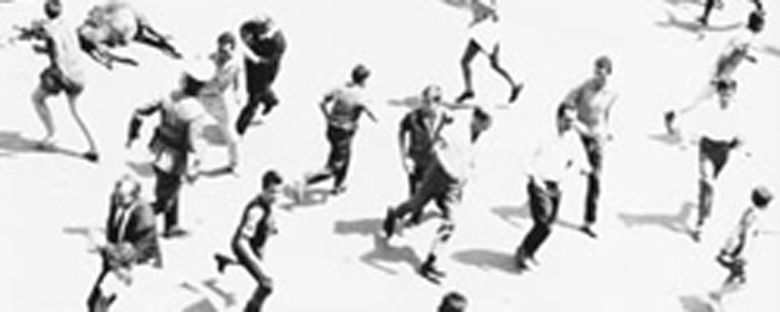Reviews
Lebenszeichen
Werner Herzog
West Germany, 1968
Credits
Review by Martha Fischer
Posted on 11 July 2005
Source New Yorker Video DVD
Related articles
Features: Directors: Werner Herzog
Signs of Life, Werner Herzog’s debut feature, is an astonishing film that impresses both on its own and as a haunting suggestion of the filmmaker Herzog would become. Set on the Greek Island of Kos during World War II, Signs of Life is a disarmingly simple work that traces a few weeks in the lives of three German soldiers who, deemed unfit for combat, are assigned to guard an arsenal in the city’s 15th century fortress. Led by Stroszek, who is still recovering from a combat injury, the soldiers — along with Stroszek’s new Greek wife, Nora — move into the fortress itself. Apart from a single symbolic display of rebellion (a stone crown on a hillside, indicating the presence of partisans), the town quietly accepts the Germans in their midst, rendering the guard duties of the trio largely a formality. As a result, their days are spent at simple tasks: painting their lodgings, fishing, and idly exploring their glorious surroundings.
Watching the film, one gets the impression that Herzog himself fell in love with Kos and created a story that would allow him to share his passion with the world. We are treated to endless, quiet shots of old men at rest, cats on stoops, and newly-washed linens, blowing in the wind. In marked contrast to the director’s later works, there is a tremendous feeling of peace to these shots, and a sense of proud, industrious lives thriving behind every wall. These are people, one feels, who are completely at ease with themselves and their lives.
In opposition stand Stroszek and his companions who, while not possessed of any concrete needs or goals, are nevertheless restless—Stroszek most of all. As time passes, he becomes increasingly uneasy inside the fortress walls, eventually confessing to his commander that he is beginning to feel trapped. In an effort to relieve Stroszek’s growing stress, the commander assigns him and a companion to a longer patrol along the upper edge of the town. Struggling in the heat, the pair stumble across a vast valley, filled with an impossible number of ragged windmills. The valley is one of those astonishing, catch-in-your-throat magical Herzog images: spreading as far as the eye can see, shot on lower quality film stock than the rest of the film, the windmills seem almost imagined, existing in a world utterly unconnected to the one in which the soldiers live. Faced with what feels like the sudden arrival of madness, Stroszek totally loses his grip on reality, threatening the lives of his wife and compatriots.
There are, however, flaws in Signs of Life. The story is paced by some jarringly sporadic narration. Stroszek’s descent into madness is never very convincing, and it does a tremendous disservice to a gentle, intelligent character, brilliantly portrayed by the rarely-seen Peter Brogle. That said, the work’s strengths far outweigh its weaknesses. Present are great hallmarks, such as like Herzog’s tremendous regard for natural beauty, his incredible gift for combining music and images, and the incredible confidence with which his camera simply watches life pass. Most interesting, though, are those things that disappear from Herzog’s work as he matures. Signs of Life lacks the intense focus on one character that characterizes virtually each of Herzog’s later films. Instead, it’s an inspired ensemble piece, packed with carefully crafted, eminently sympathetic characters, inhabited flawlessly by a largely unknown cast.
Signs of Life is among Herzog’s simplest features. It’s a delightfully quiet, respectful exploration of lives of little consequence, dotted with moments of profound beauty and joy. It’s truly a pleasure to watch Herzog’s genius unleashed for the first time, and to think of everything that lies ahead of this brash young director.
We don’t do comments anymore, but you may contact us here or find us on Twitter or Facebook.



